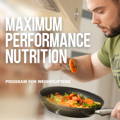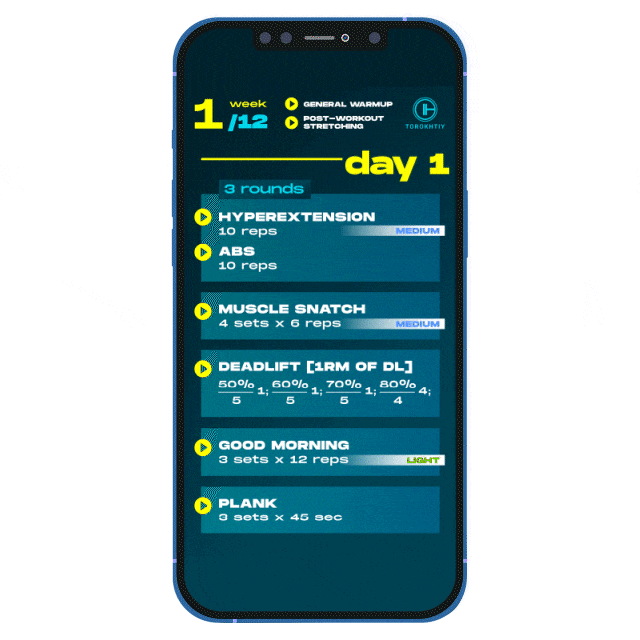The answer is yes, 100%! Deadlift only program is a completely new program. This deadlift cycle is unique, fun, and add a different stimulus each week. We are implementing hypertrophy, power, and absolute strength to keep you healthy while building strength, athleticism and improving your lifts.
PROGRAM STRUCTURE
The deadlift workout program is broken up into 3 blocks of 4 weeks:
Accumulation period (week 1-4)
🎯 Focus on general strength and basic coordination.
📊Training load: high volume, average intensity.
Transmutation period (week 5-8)
🎯 Focus on intensive training for new result.
📊 Training load: high volume & intensity.
Deload & taper period (week 9-12)
🎯 Focus on preparation for peaking phase & PR.
📊 Training load: low volume, high intensity.
PROGRAM DETAILS

DURATION:
12 weeks / 3 days a week / 60-90 minutes.
TRAINING GOAL:
New DEADLIFT PR, Strength development.
TRAINING LEVEL:
Intermediate to Advanced.
GOOD FOR:
Male & Female athletes.
EQUIPMENT NEEDED:
Access to basic OLY equipment is suggested.
Сomparison of Torokhtiy Training Programs.
Use this program guide to learn about Torokhtiy programs and compare their benefits.
TRAINING ROUTINE

According to this training plan, you will perform deadlift exercises only 3 times a week:
Mon: Training
Tue: Day-off
Wed: Training
Thu: Day-off
Fri: Training
Sat: Day-off
Sun: Day-off
It is asked that you follow a straightforward pattern of one day on, one day off to allow your body a day to recover between bouts of training.
You will train just 3 times per week under this program:
Mon: Training
Tue: Day-off
Wed: Training
Thu: Day-off
Fri: Training
Sat: Day-off
Sun: Day-off
It is asked that you follow a straightforward pattern of one day on, one day off to allow your body a day to recover between bouts of training.

PROGRESSION BREAKDOWN

✔The volume (in terms of sets of deadlifts) increases over the first few weeks and peaks in weeks 7 and 8, following an inverted U-shape.
✔The peak % of 1RM climbs from 75% of 1RM in week one to 102.5% (your new max attempt) in week 13.
✔Session 2 provides a low intensity Olympic weightlifting load weekly to provide technical training and muscle memory support.
PROGRAM UPDATE

We want you to have access and the best possible training experience. That's why my team has been hard at work on an updated DEADLIFT version for all your needs!
Here’s what’s new in this program:
✔NEW! Interactive video library;
✔NEW! Pre and post-workout stretch;
✔NEW! Detailed special warmup;
✔NEW! Supplementary exercises to attack your weak points;
✔NEW! More exercises to strengthen your core;
✔NEW! Strength Training Reps and Sets Schemes;
✔NEW! Truly interactive design;
✔NEW! Mobile version for greater viewer experience even on small screens.
✔NEW! Available through the TrainHeroic App.

THIS OLYMPIC DEADLIFT PROGRAM IS IDEAL FOR

✔increasing your deadlift 1RM;
✔building a solid foundation of strength and muscle mass;
✔boosting pulling power for Olympic weightlifting improvement;
✔busting through a strength and training plateau.
PROPER NUTRITION

The nutrition plan is one of the most important factors in weightlifting and can help you achieve your personal training objectives.
That's why we recommend combining our 12 week DEADLIFT program with the Performance Nutrition plan, which has been specially designed to fit the specific energy needs of weightlifters.
PERFORMANCE NUTRITION plan provides the perfect balance of nutrients for athletes with specific training loads and recovery dynamics.

PRICING

DEADLIFT 1.0

Olympic Deadlift

Olympic Deadlift + Nutrition
12-week training plan
✓
✓
✓
Release year
2017
2022
2022
Workout Tutorial Videos
−
✓
✓
Performance Nutrition
−
−
✓
−
✓
✓
#LifeTime Access
✓
✓
✓
Men's Maximum Performance Nutrition is selected by default.
To get Women's Nutrition Program contact us via online chat on the page or via email - direct@torokhtiy.com

DEADLIFT 1.0

Olympic Deadlift

Olympic Deadlift + Nutrition
12-week training plan
Release year
Mobile-friendly version
Workout Tutorial Videos
−
Performance Nutrition
−
#LifeTime Access
Men's Maximum Performance Nutrition is selected by default. To get Women's Nutrition Program contact us via online chat on the page or via email - direct@torokhtiy.com
The best way to learn more about the Olympic Deadlift Program is to try it out.
The First 3 workouts are for free.


Questions? Look Here!
Or Email Us direct@torokhtiy.com
Do I need a new Olympic Deadlift program if I trained according to the Deadlift 1.0 program?
How frequently should I train?
This best deadlift program is designed to be 3 days per week. We do not recommend training 3 days in a row. On your rest days, try to plan recovery activities, such as massages, or sauna.
Can I combine it with other types of training?
We do not recommend combining this increase deadlift program with other high-intensity workouts. You can add, at your discretion, recovery activities to develop flexibility and mobility, as well as short (up to 30 minutes) low-intensity cardio work (walking, rowing, swimming). Be sure to plan one full day off in each weekly cycle. The program's effectiveness largely depends on your responsibility when it comes to the training process, sleep, nutrition, and recovery. Train smart, get enough rest.
Is it necessary to train in weightlifting shoes?
We highly recommend you to wear weightlifting shoes during this deadlift program pdf, also known as Lifters. Whether you’re a functional fitness athlete or a weightlifter, you will find them beneficial.
What equipment do I need to progress in this deadlift program?
What if I have more questions?
Please contact us at direct@torokhtiy.com
RECOMMENDED PROGRAMS